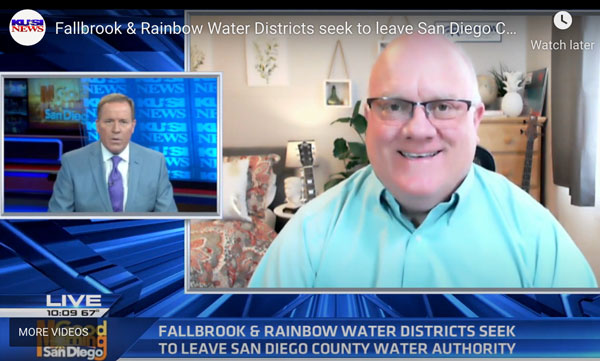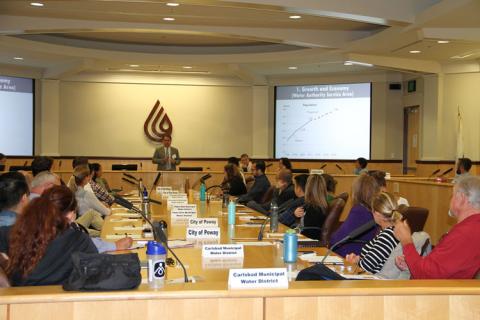[ESPAÑOL]
By Alberto Garcia
Two rural water districts in North County want to leave the San Diego County Water Authority group of local water agencies and force the remaining water customers to finance the region’s delivery and treatment systems.
In a recent television interview, Tom Kennedy, General Manager of the Rainbow Municipal District, explained that his district and the Fallbrook Public Utility District have asked a state agency to approve their request to leave the San Diego regional agencies comprised of 24 water agencies.
Kennedy stated that the two Northern agencies want to purchase water from the Eastern Municipal Water District that currently serves 850,000 people in western Riverside County.
“With Eastern, we will have an equally reliable supply of water and our ratepayers won’t have to continue subsidizing water districts in other parts of the county which actually do benefit from these infrastructure projects,” Kennedy said.
But other San Diego water agencies argue that regional water systems have been approved by the regional board in the past and financed through bonds that were calculated to be spread out all water users in the County, and by leaving, Rainbow and Fallbrook would be abandoning their share of the debt.
There is a long history of water wars between northern rural water districts that primarily serve farmers and southern districts that serve urban and suburban neighborhoods and businesses.
Larger districts have also suggested that some water agencies are too small and inefficient, with each having general managers that each earns over $250,000 per year. Consolidation of smaller district, some argue, would result in better long-term decisions and reductions in duplicative administrative bureaucracies.
Critics of the split among local agencies argue that highly-paid water managers from smaller agricultural districts have aligned with with the Los Angeles-based Metropolitan Water District to undermine San Diego ratepayers in more urbanized areas like San Diego and the South Bay.
Central San Diego and South Bay communities could be forced to pay higher water rates to subside high water users like avocado farmers in North County.
Any change in the makeup of the San Diego County Water Authority (SDCWA) would have to be approved by LAFCO, the Local Area Formation Commission, a state-created entity with regulatory and planning powers to “coordinate and oversee the establishment, expansion, and organization of cities, towns, and special districts as well as their municipal service areas.”
The SDCWA Board of Directors includes 36 Board Members chosen from the 24 member water agencies in the County. Board members include community leaders, member water agency general managers, and member water agency elected officials.
La Prensa San Diego has filed requests under the California Public Records Act to several member agencies seeking information on their internal communications relating to the SDCWA, as well as individual expenses related to general members salaries, per diem pay they receive for attending other meetings, and their own board policies for general managers attending SDCWA meetings.

